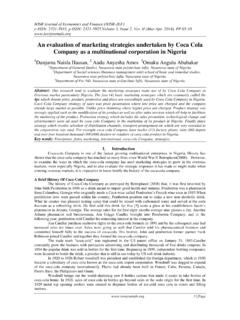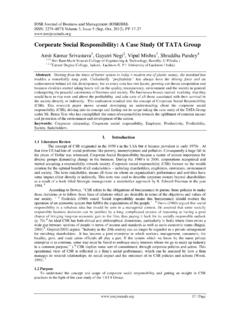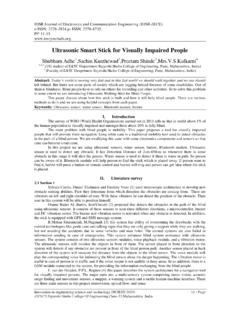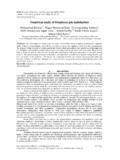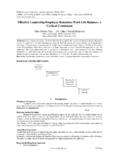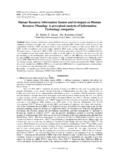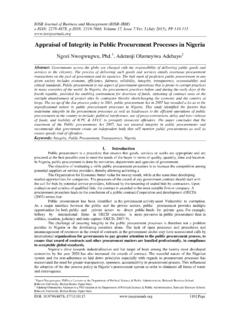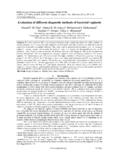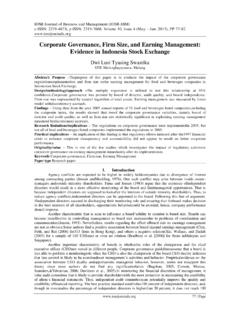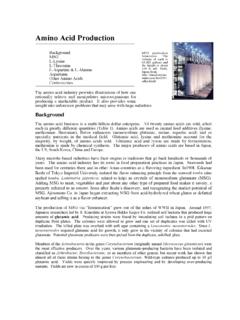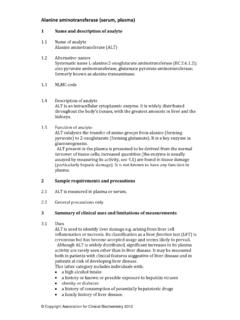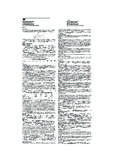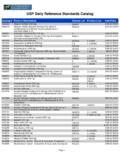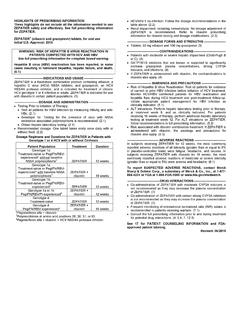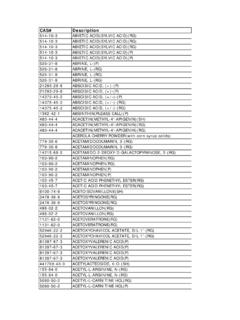Transcription of Evaluation of Serum Aspartate Aminotransferase (AST ...
1 IOSR Journal of Dental and Medical Sciences (IOSR-JDMS) e-ISSN: 2279-0853, p-ISSN: 14, Issue 6 Ver. III (Jun. 2015), PP 10-12 DOI: 10 | Page Evaluation of Serum Aspartate Aminotransferase (AST), alanine Aminotransferase (ALT), Alkaline Phosphatase (ALP), Lactate Dehydrogenase (LDH) and Uric Acid In Preeclampsia Julie Sarmah Assistant Professor, Deptt. of Biochemistry, Tezpur Medical College, Tezpur, Assam,India. Abstract: Preeclampsia occurs after 20 weeks of gestation in previously normotensive pregnant women, characterized by blood pressure above 140/90 mm of Hg and proteinuria at least 300mg/24 hrs. causing damage to liver, kidney and other end organ. A study was undertaken to evaluate the Serum concentration of AST, ALT, ALP, LDH and uric Acid in preeclamptic women and the results were compared with that normal pregnant woman.
2 The hospital based case control study consisting of two groups-case group(n=30),with women having preeclampsia and control group(n=30) with normal pregnant women were considered. Subjects in both the groups were of more than 20 weeks of gestation and age group 20-35 years . Serum levels of all the parameters studied were measured by fully automated analyzerVitros 250 using vitros reagent packs. Statistical analysis was done using student s t test and p value significant increase in Serum level of all the measured parameters were found in preeclamptic women when compared with normal pregnant women. The results were comparable with values obtained by other researchers. An early detection of increase in Serum level these parameters in at risk pregnant women may help in preventing maternal and fetal complications.
3 Keywords: alanine Aminotransferase , Alkaline phosphatase, Aspartate Aminotransferase , Endothelial dysfunction, Lactate dehydrogenase, Preeclampsia, Uric acid. I. Introduction Pre-eclampsia is a form of hypertensive disorder of pregnancy. According to the report of the National High Blood pressure Education Program Working Group on High Blood Pressure in Pregnancy, the diagnosis of preeclampsia is determined by de-novo appearance of hypertension after mid pregnancy (more than 20 weeks of gestation) with proteinuria at least 300mg/24 hrs [1]. The worldwide incidence of preeclampsia varies greatly and it ranges between 2% and 10% of pregnancies. WHO estimated the incidence of preeclampsia to be seven times higher in developing countries ( of live births) than in developed countries ( ) [2].
4 The incidence is more in primigravida compared to multigravida. It is one of the major cause of maternal and fetal morbidity and mortality[3]. Preeclampsia may be associated with certain complications in fetus like intrauterine growth restriction, prematurity, and may also lead to death of the fetus. In case of preeclamptic women there may be development of hepatic and renal failure, pulmonary oedema and even stroke. Pre-eclampsia may also progress to eclampsia, which is a form of hypertensive disorder of pregnancy with convulsion [4]. Preeclampsia is a multisystem disorder. It have been termed as the diseases of theories because several theories were postulated to understand the pathophysiological basis of the disease[5,6].Some theories [3,7] indicate genetic abnormality, immunological intolerance between feto-placental and maternal tissues and oxidative stress as some of the causes of the disease.
5 Some theories [3,8] also suggest that it occurs due to defective placental implementation that leads to narrowing of the uterine spiral arterioles causing placental ischemia. Placental ischemia leads to alteration in expression of various factors causing maternal endothelial dysfunction. Wide spread maternal endothelial dysfunction causes vasoconstriction and end-organ ischemia which in turn results in systemic hypertension, liver dysfunction, renal dysfunction and cerebrovascular pathology. Several studies [9] have been carried out but there is no clinically useful screening test for the early diagnosis of the disease. As there is likely derangement in the functions of the liver and kidney in preeclampsia, a study on the biochemical changes that occur in the parameters associated to these organs may help in the early diagnosis of the disease.
6 Increase in Serum uric acid level in preeclampsia was first reported by Slemons and Bogert in 1917[10]. Therefore, this study was undertaken to evaluate the changes in the concentration of some of the liver enzymes - Aspartate Aminotransferase (AST), alanine Aminotransferase (ALT), Alkaline Phosphatase (ALP), Lactate dehydrogenase (LDH) and a excretory product of kidney uric acid in the Serum of the preeclamptic women and to compare the results with the values obtained in normal pregnant women. Evaluation of Serum Aspartate Aminotransferase (AST), alanine Aminotransferase (ALT).. DOI: 11 | Page II. Materials And Methods The study was conducted in the Biochemistry Wing of the Central Clinical Laboratory of Tezpur Medical College, Tezpur.
7 The subjects for the study were selected from the Department of Obstetrics and Gynaecology, Tezpur Medical College after taking proper history and clinical examination and screening for 24 hours urinary protein. The subjects were divided into two groups Case group and Control group. Case group included 30 (thirty) diagnosed and confirmed cases of preeclampsia of 20-35 years of age. Control group included 30(thirty) age matched healthy normotensive pregnant women with more than 20 weeks of gestation. The inclusion criteria for the study groups were pregnant women of more than 20 weeks of gestation with blood pressure above 140/90 mm of Hg noted for the first time during pregnancy in 2 (two)occasions at least 6(six) hours apart with proteinuria at least 300 mg/24 hours in case group and healthy normotensive pregnant women of more than 20 weeks of gestation in the control group.
8 The age group considered was 20-35 years of age. The exclusion criteria for the study were pregnant women with the history of chronic hypertension, diabetes mellitus, liver, renal and cardiac diseases, urinary tract infection, smoking, alcoholism or any other major illness. Under all aseptic and antiseptic condition 5 ml of venous blood sample were collected in the vacutainer after obtaining informed consent from the subjects under study. Blood samples were kept aside for 30 min and allowed to clot. The samples were then centrifuged at 2000rpm for 10 min and clear supernatant Serum obtained. The blood investigation for Serum AST, ALT, ALP, LDH and Uric acid were done in fully automated analyser Vitros 250 using Vitros reagent packs. Statistical analysis were done by finding out mean standard deviation for each parameter under study and the values of the parameters of the cases were compared with that of the control by performing student s t test and the level of significance were determined by p value.
9 P value of < was considered significant. III. Results The findings of the different parameter under study for both the case group and control group after statistical analysis and there p value are depicted in the tabular form (TABLE1): TABLE 1: The Mean SD Of Different Parameters In Control Group And Case Group Along With p Value . Parameters under study Control group Mean SD Case group Mean SD P value AST(U/L) < ALT(U/L) ALP(U/L) < LDH(U/L) < Uric acid(mg/dl) < IV. Discussions In this study, Serum AST level in case group was U/L compared to U/L in the control group with a p value < which was highly significant. Serum ALT level in case group was U/L compared to U/L in the control group with p value which was also significant.
10 Therefore, in this study, there was significant increase in Serum AST and ALT concentration in pre-eclampsia compared to normal pregnant women. Malvino et al[11] also found a significant increase in level of Serum AST (209 178U/L)and ALT ( 271 297U/L)in preeclamptic patient. Rath et al[12] ,Girling et al [13]also noticed an increase in Serum AST and ALT level in preeclampsia due to hepatic dysfunction . Serum ALP level in preeclamptic case group was U/L and in normal pregnant control group was U/L with p value< highly significant in the study. A significant increase in Serum ALP level in preeclampsia was observed by Makuyana et al (p< ) [14], Wong et al [15] and Adeniyi et al [16] in their studies. There are several isoenzyme form of ALP that contributes its Serum level in normal person.
